September 21, 2007
Air Date: September 21, 2007
FULL SHOW
SEGMENTS
Arctic Gender Imbalance
View the page for this story
Only girls are being born in a village in Greenland. Host Steve Curwood turns to Lars Otto Reiersen, of the Arctic Monitoring and Assessment Program, to find out what may be behind a growing gender imbalance in babies born around the Arctic Circle. (05:00)
Averting Seismic Disaster
/ Jean KumagaiView the page for this story
Earthquakes are common in Japan and some have devastating consequences. The Japanese government is implementing a seismic warning network that will give residents a few seconds lead time when an earthquake is coming in hopes of averting disaster. Spectrum Radio’s Jean Kumagai reports. (07:00)
Dueling Climate Conferences?
/ Jeff YoungView the page for this story
Both the United Nations and the White House will sponsor special conferences on climate change, as the world's leaders ponder future global warming agreements. Living on Earth's Jeff Young reports that two sharply different visions will be on display: President Bush's voluntary approach versus mandatory emissions reductions. (05:30)
Climate Diplomacy
View the page for this story
With China onboard for UN climate talks in Bali this December, the Bush administration appears increasingly isolated in its continued resistance to call for mandatory caps on carbon emissions. Living on Earth talks with Jennifer Morgan, who advises the German government on climate change. (06:00)
The Bottom Line on Climate Change
View the page for this story
New York’s Attorney General has subpoenaed five energy companies, charging they did not disclose the financial risks of climate change to their shareholders. Host Steve Curwood talks with Vermont Law School professor Pat Parenteau about the move. (05:30)
Cool Fix/Goloco
/ Mitra TajView the page for this story
Carpooling reduces carbon emissions, and now you can find a ride online, reports Living on Earth’s Mitra Taj. (01:30)
Liberation Ecology
View the page for this story
In Latin America, Catholic priests and nuns are confronting loggers and miners from multinational companies on behalf of the poor. Host Steve Curwood talks with Sierra Magazine writer Merilyn Berlin Snell about her recent article, “Bulldozers and Blasphemy.” (08:30)
The Name Game
View the page for this story
Prince Albert II of Monaco has teamed up with Conservation International to host a benefit aimed at raising money for Indonesian conservation efforts. Up on the block are the naming rights for ten new marine species. Peter Seligmann, CEO and founder of Conservation International, tells host Steve Curwood the reasoning behind the “Blue Auction.” (05:00)
Alex (1976 – 2007)
/ Sy MontgomeryView the page for this story
When Alex the Grey parrot died this month, author Sy Montgomery says the world lost a bird who broke down the barrier between animals and humans. She offers this tribute. (03:15)
Show Credits and Funders
Show Transcript
HOST: Steve Curwood
GUESTS: Lars Otto Reiersen, Jennifer Morgan, Patrick Parenteau, Marilyn Berlin Snell, Peter Seligmann
REPORTERS: Jeff Young, Jean Kumagai
COMMENTATOR: Sy Montgomery
COOL FIX: Mitra Taj
[THEME]
CURWOOD: From Public Radio International—this is Living on Earth.
[THEME]
CURWOOD: I’m Steve Curwood. The attorney general of New York State is investigating if coal-related companies have violated laws by failing to tell investors of the risks global warming presents to their businesses. It may have a chilling effect on investments in coal.
PARENTEAU: What we’re seeing at this instance is the effect of climate change on financial markets, on investor confidence, on who bears the risks, and all of these questions are brand new.
CURWOOD: Also pollution is being linked to a sharp reduction in the number of baby boys being born in the far north. One place in Greenland has only girl babies.
And the passing of a parrot who taught humans about the nature of life.
MONTGOMERY: When Alex spoke, a member of a species more closely related to dinosaurs than to humans was talking with us.
CURWOOD: We’ll have those stories and more this week on Living on Earth—stick around!
ANNOUNCER: Support for Living on Earth comes from the National Science Foundation and Stonyfield Farm.
[THEME]
Arctic Gender Imbalance
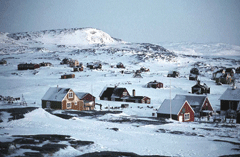
(Courtesy of www.bigfoto.com)
CURWOOD: From the Jennifer and Ted Stanley Studios in Somerville, Massachusetts - this is Living on Earth. I’m Steve Curwood. In certain villages in northern Greenland something is completely out of whack—only girls are being born. These reports from villages near the U.S. Air Force base in Thule are now being explored by scientists.
But studies conducted a few years ago now coming to light show that in other Arctic regions, the sex ratios of babies are also out of kilter. In 2004 the Arctic Monitoring and Assessment Program found a correlation between exposure to PCBs and shifts in the sex ratios of babies born to indigenous mothers living in the northern reaches of Russia. PCBs and other persistent organic chemicals such as pesticides travel from industrial countries up the food chain into the blubber of marine mammals.
Lars Otto Reiersen is the executive secretary for the Arctic Monitoring and Assessment Program. His group conducted the study as part of ongoing research on pollution, diet and health in the region.
REIERSEN: The most interesting and surprising result was that we saw a change in the sex ratio that we could correlate to the levels of PCB in the mother’s blood. And we saw that if the mother had more than four micrograms per liter in her blood the average was to change two girls per boy in the population that we studied. And that’s a quite dramatic change from a normal situation where there are more boys than girls born.
CURWOOD: Now when you say more boys than girls born, how many more boys than girls?
REIERSEN: I think normally—statistically—there is 1.05 or 1.1 boy per girl. That’s the normal average.
CURWOOD: In this population though it’s 2.0 girls per boy.
REIERSEN: Yeah, when the mothers have these levels of PCB, yeah. And we also saw that the birth came earlier and the weight on the newborn babies that had the highest levels were lower than the normal.
CURWOOD: Tell me about how you went about collecting your data. How did you find your subjects? Who were these people?
REIERSEN: Based on the study we’d done in Greenland and Canada we are focusing mainly on the indigenous people living off the marine food chain because we’ve seen that these people have the highest levels because of their lifestyle. And we worked together with the indigenous people to collect the samples over a year’s period to get enough statistical data. And we have continued after that. The first report was published in 2004 and the new data just confirmed what we saw earlier. So what we’re looking into now is to try to understand what is the mechanism behind it.

Arctic community (Courtesy of www.bigfoto.com)
CURWOOD: Now, looking at your report here I’m just struck by the apparent effects that PCBs have on the sex ratio of children and the way it changes. The chart you have there, I’m looking at page 175. The chart that you have there shows that as you increase exposure to PCBs, at first you get way more boy babies than girl babies. But then as you go higher and you get above four micrograms per liter of blood you get way more girl babies.
REIERSEN: Yes, I can see that. And the scientists do not have any good explanation of why it looks like you have a stimulation at the lower levels and then you get the opposite effect when you go beyond that level. So, what we’re doing now is that we’re looking into the certain polar arctic to see—do we see any similar effects in Canada or Greenland?
CURWOOD: How might PCBs do this do you think?
REIERSEN: Well, it could be what we call the mimic of the hormones. That early in the pregnancy that some of these pesticides may mimic testosterone or estrogen. That’s documented from science. So, that might be what’s occurring but that’s too early to say for sure what’s the mechanism.
CURWOOD: Now, PCBs are concentrated in the arctic and concentrated in marine mammals. But what might this mean for the rest of us around the world who have exposure to PCBs but at a much lower level?
REIERSEN: That’s a good question. PCB is all over, it’s not only in the Arctic. You have it all over the world in the terrestrial and marine food chain, and in fresh water. So, from laboratory studies we know that PCBs may effect reproduction, may have effects on cancer and immune systems. But I think it’s very difficult to document that on the population level. You have to have very detailed studies like the one we did in Chukotka area.
CURWOOD: How have the governments of the Arctic responded to your research?
REIERSEN: Well, they have responded very active. I think you have got the Stockholm Convention in place to a far extent due to the work we have done in the Arctic over the years.
CURWOOD: And the Stockholm Convention is?
REIERSEN: That is an international agreement among countries to reduce the production and use and discharge of persistent organics. I think that is what you need actions to clean up the use of PCB and the old waste sites of PCB and others of these chemicals. That’s important actions to be taken.
CURWOOD: Lars Otto Reiersen is the executive secretary for the Arctic Monitoring and Assessment Program. Thank you so much, sir.
REIERSEN: Thank you.
CURWOOD: For a link to the Arctic pollution study, visit our website: L-O-E dot org.
Related links:
- The Arctic Monitoring and Assessment Program
- To read part of the study concerning gender imbalance
- Big Photo Website
[MUSIC: Hamilton De Holanda “Beatriz” from ‘Intimo’ (Adventure Music—2007)]
Averting Seismic Disaster
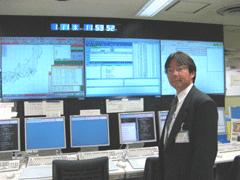
Osamu Kamigaichi in the Japan Meteorological Agency Control Center.(Photo: Jean Kumagi)
CURWOOD: Japan has been hit hard by earthquakes over the years, most recently by a 6.8 trembler in northwestern Japan, that claimed 11 lives and shut down the world’s largest nuclear power plant. So Japan has a strong incentive to figure out how to predict earthquakes and it’s making some progress. The government has developed a sophisticated earthquake-warning system that can sound an alarm a few precious seconds before the most destructive waves of an earthquake hit.
Spectrum Radio’s Jean Kumagai has our story.
[SOUND FROM DISASTER PREVENTION DAY; SIREN]
KUMAGAI: September in Japan always begins the same way: Disaster Prevention Day. Across the country, schoolchildren don protective headgear and practice taking cover under sturdy desks; public-safety workers conduct mock searches and rescues; and medical personnel attend to the faux injured.
[MORE SOUND FROM DISASTER PREVENTION DAY; SHOUTING]
KUMAGAI: This annual ritual underscores a simple fact of life for the Japanese: earthquakes happen. The country experiences more than a thousand earthquakes each year. Most of these are too small to do real damage. But major quakes have claimed hundreds of thousands of lives in Japan over the centuries.
[SOUND: NEWSCASTER REPORTING “THIS MORNING AT FIRST LIGHT, IT WAS IMPOSSIBLE TO DETECT THE TRAUMA THAT HAS HIT THE CITY OF KOBE, ONCE RENOWNED FOR ITS STYLE AND ITS BEAUTY . . . " (FADES)]
KUMAGAI: Just before dawn on January 17, 1995, a magnitude 7.2 earthquake flattened large sections of the city of Kobe. Sixty-four hundred people perished, and many thousands more were injured. Naoko Onda was living outside Kobe when the ground started to move.
ONDA: I was at home and reading a book to be ready to go to work. Suddenly from the bottom under the floor I feel going up, up, up and suddenly lift and suddenly big shake. And I was not able to stand up and the window to the balcony was open, even though it had been locked.

Osamu Kamigaichi in the Japan Meteorological Agency Control Center (Photo: Jean Kumagi)
Data from the seismic stations is routed to the Japan Meteorological Agency, or JMA, in Tokyo. The JMA control center is a large room filled with computers, large flat-screen monitors, and other equipment. At one end, a bank of screens displays various types of seismic data. Osamu Kamigaichi is JMA’s senior coordinator for international earthquake and tsunami information.
KAMIGAICHI: Earthquake early warning is a fully automated system. Otherwise we cannot disseminate timely information to the public.
KUMAGAI: As Kamigaichi talks, the automated system emits a warning.
[WARNING SOUND; BUZZING; AUTOMATED VOICE]
KUMAGAI: It’s a false alarm, and so the warning won’t travel beyond the control center. But in the event of a real earthquake, additional information would soon follow, and an official alert would then be issued. At most, the advance warning amounts to mere seconds.
[WARNING SOUND; BUZZING]
KUMAGAI: That may not seem like a lot of time, but for equipment controlled by a microprocessor, it’s usually long enough to react. For example, elevators tend to jam between floors when strong shaking sends their cables swinging. But with a 10-second lead time, a moving elevator could stop at the closest floor and open its doors. In fact, all 227,000 elevators in Japan must now be equipped with control systems that accept the JMA signals. The alerts could also trigger automated responses at power and chemical plants, computer and communications networks, trains, and hospitals.
[SOUND OF MAN SPEAKING IN JAPANESE]
KUMAGAI: Masanori Kanazawa and his orange tabby cat live in one of the dozen or so apartment complexes in Tokyo that provide the alerts to their residents. During a recent demonstration, he was sitting on his living room couch reading the newspaper when the alarm began to sound.
[SOUND OF HIGH-PITCHED ALARM; AUTOMATED VOICE]
KUMAGAI: As the prerecorded voice counts down the seconds to the earthquake’s arrival, Kanazawa jumps to his feet, pads into the kitchen to check that the gas stove isn’t on, and then heads for the front door, presumably to safety. Kanazawa says all of his friends now want an earthquake warning system, too.
[KANAZAWA SPEAKING IN JAPANESE]
TRANSLATOR: After I bought this apartment, I told my friends about the earthquake early warning system and they said that they envy me. They really think it’s safer to have this system in the house.
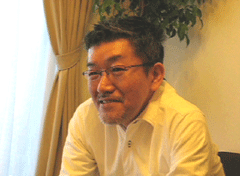
Masanori Kanazawa (Photo: Jean Kumagi)
HEATON: Earthquakes are a phenomenon that take us by surprise, they do just tremendous damage—change the state of everything in just a few brief moments, from peacetime into total and utter chaos. One of challenges is to try to deal with that chaos in some new, creative ways. We think the key to that is having good information, as quickly as possible.
KUMAGAI: In other words, the right kind of information can save lives. For Living on Earth, I’m Jean Kumagai.
CURWOOD: Jean Kumagai reports for Spectrum Radio, the broadcast edition of I triple E Spectrum Magazine.
Related links:
- IEEE Spectrum article “How to Master A Seismic Disaster”
- IEEE Spectrum slideshow of Earthquake Sensors
[MUSIC: Hamilton de Holanda “Samba Do Soho” from ‘Intimo’ (Adventure Music—2007)]
CURWOOD: Coming up: New York State launches an investigation into the financing of coal power plants. Keep listening to Living on Earth.
Dueling Climate Conferences?

The Ole’ Blue Marble, with coastlines still intact.(Photo: Reto Stoekli, NASA Goddard Space Flight Center)
CURWOOD: It’s Living on Earth. I’m Steve Curwood. Global warming is topping the agenda as the United Nations General Assembly opens in New York on Sept 26, and later in the week in Washington, President Bush is hosting diplomats from the world’s major economies for a global warming conference. All this comes as the UN negotiators prepare to meet in Bali in December to hash out what might replace the Kyoto Protocol, which expires in 2012.
Kyoto calls for the rich industrialized nations to reduce their emissions first and help developing countries constrain emissions in the future. Living on Earth’s Washington correspondent Jeff Young takes a look at what’s at stake for the meetings in New York and Washington.
YOUNG: The United Nations says its one-day event will be the largest-ever meeting of world leaders on climate change, with more than 70 heads of state. UN Secretary General Ban Ki-moon knows the clock is ticking on the Kyoto Protocol and reaching a new agreement will take time. He’s not happy with the pace of talks so far.
KI-MOON: We need to move fast and reach a bold agreement by 2009 so that it can enter into force by the end of 2012.
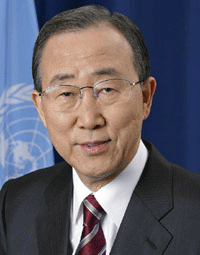
Secretary of the United Nations, Ban Ki-Moon.(Courtesy of the United Nations)
YOUNG: After the UN meeting, climate action moves to Washington where President Bush has asked the leaders of the world’s major economies to the White House. Bush says he, too, wants to help forge a new climate framework.
BUSH: So my proposal is this: By the end of next year America and other nations will set a long-term, global goal for reducing greenhouse gases. To help develop this goal, the United States will convene a series of meetings of nations that produce most greenhouse gas emissions, including nations with rapidly growing economies like India and China.
YOUNG: It was a surprising invitation from an administration that takes a lot of heat on global warming. Critics say the White House ignores the science on climate change. But the president’s top science advisor begs to differ. John Marburger directs the White House Office of Science and Technology Policy. Marburger says the president agrees with the scientific consensus that the climate is changing and that human activity is most likely the cause.
MARBURGER: There’s no question that the president himself has embraced the appropriate scientific findings regarding climate change almost from the beginning of the administration. He says the earth is warming and we’re producing too much CO2, we need to take responsibility for our emissions. And he understands it. The policies are being made in the context of a much higher level of understanding of the science than I think most people are aware.
YOUNG: Is the White House stance on climate change changing? Massachusetts Democratic Senator John Kerry says he doubts it.
KERRY: Is it better that they are finally talking the language of saying
‘we accept the science, or we see global climate change?’ Yes, of course. This has been a 7-year struggle with this administration to get them where they should have been 7 years ago. So I’m not going to jump up and down over the fact of the conference until we see what the outcome is, obviously.
YOUNG: Kerry cosponsors a bill before Congress that would put a mandatory cap on U.S. carbon emissions. He says most of the world’s developed countries already limit CO2. And he thinks binding mandatory reductions should be the basis for the next international agreement. Kerry worries that the White House conference’s emphasis on voluntary measures could make it tougher for the UN to get deeper carbon cuts.
KERRY: There is a concern about this White House undermining efforts on a global basis; they’ve done that everywhere they’ve been. This administration has been a rigorous opponent of responsible action on global climate change.
YOUNG: Officials at the White House Council on Environmental Quality were not available for an interview. The council’s spokesperson offered a written statement that says, ‘Not only does this process have the support of the G8 leaders but we have the support of the UN Secretary General and the head of the UN Framework Convention on Climate Change. White House science advisor Marburger also defends the U.S. approach to climate.
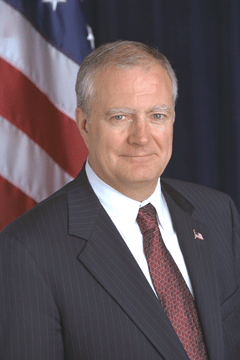
John Marburger, chief Science Advisor to President Bush.(Courtesy of White House Office of Science and Technology Policy)
MARBURGER: People have been hung up on this issue—whether it’s
happening or not, or whether there should be caps, or what the targets should be. And the U.S. has just gone ahead and invested in these technologies. I feel more comfortable about actions that the U.S. has taken than I do about much of the rest of the world because we are investing in new energy technologies, which is what is necessary.
YOUNG: Marburger says sharing new energy technology will draw countries like China into a climate agreement. But Elliot Diringer at the Pew Center on Climate Change says mandatory carbon cuts would do more to actually get the clean energy technology into use.
DIRINGER: The White House has used terms like ‘aspirational,’ ‘bottom up,’ ‘pledge and review’—all of those mean ‘voluntary.’ What has now come to fore is really sharply contrasting visions of the future climate framework: will it be built primarily on voluntary actions or will it entail or involve some form of binding commitments?
YOUNG: The coming week could show which path world leaders want to take. For Living on Earth, I’m Jeff Young in Washington.
CURWOOD: You can hear more of Jeff Young’s interview with President Bush’s top science advisor at our website: l-o-e dot org.
Related links:
- UN climate conference agenda and background
- US State Dept. page on the White House climate conference
- Pew Climate Center
- White House office of Science and Technology Policy
- National Academies report on effectiveness of White house climate science program
- Listen to an extended interview with President Bush's top science advisor, John Marburger.
Climate Diplomacy
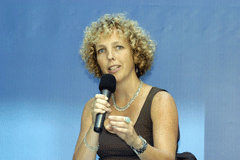
Jennifer Morgan (Courtesy of Jennifer Morgan)
CURWOOD: Now for an international perspective we turn to Jennifer Morgan, who is an advisor to the German government and director of the Climate Change Program for the British advocacy group E3G.
The United States and China are the largest emitters of global warming gasses so a lot of the upcoming negotiations are focused on those two countries—the U.S., which repudiated Kyoto, and China, which has ratified Kyoto but is not bound under it to cap emissions. I asked Jennifer Morgan to explain the position of China, and its president, Hu Jintao.
MORGAN: My understanding of the Chinese position is that they very much recognize their responsibility in causing climate change and are ready to act to curb their emissions but that they don’t think that they should have to take on the same type of commitment as developed countries should. They are still working through raising people out of poverty, etcetera. And their per capita emissions are much lower than the West. So their very clear message is, ‘we want to do more and do it under the UN and not under any framework that’s competing with it but we’re not ready to take on a national cap but we’re ready to curb out emissions.’
CURWOOD: So, how does Hu’s position now contrast to the stance taken by the United States and what the U.S. is saying it’d like to see out of China?
MORGAN: Well, the U.S. does not differentiate between itself—or I should say the Bush administration—does not differentiate between itself and China in the level of ambition or effort that each should do. In other words, the Bush administration does not seem to feel that it has any greater responsibility because it has more historical emissions than China. So, what Bush seems to want to do is invite everybody to come and pledge to do something in a non-UN format, versus Hu Jintao, who’s saying ‘we want to do more but we want to do it in a multilateral framework.’ And I think besides the Bush administration, what I sense is a feeling of consensus that we know we all need to do our fair share and developing countries, including China, have used those words. And we need a plan, we need a mandate. We need a serious negotiation in order to crack that and that needs to start in Bali.

Jennifer Morgan(Courtesy of Jennifer Morgan)
MORGAN: Well, it is a tremendous challenge for other countries sitting at a negotiating table with an administration that they know really hasn’t fundamentally changed its opposition to reducing its emissions but is still in power for 18 more months. While they look at the array of initiatives in the United States—from governors to senators to even what presidential candidates are saying—and figure out how they start negotiations with the Bush administration at the table knowing that those negotiations will end after that administration is out of power. And my experience in these negotiations is that those countries will need to come together. Europe will need to build partnerships and alliances with the big developing countries and Japan in order to overcome Bush administration opposition because we may or most likely will be facing a situation in Bali where we have a unified world that can bring breakthroughs and the question for President Bush is—is he ready to stand up and block that?
CURWOOD: Now, for people who don’t pay close attention to diplomatic matters this sounds all very abstruse. In other words what’s going to happen in Bali is perhaps an agreement to have negotiations to keep talking? What’s really at stake in Bali?
MORGAN: We face a very short time frame where we have to shift trillions of dollars of investment from very high-carbon-intensive coal and oil into renewable energy, energy efficiency, zero-emission technologies. And in order to do that the market needs very clear signals. They need to know that industrialized countries are going to cut their emissions dramatically and that developing countries are also going to change their development paths to do it in a lower carbon way.
What’s at stake in Bali really is a signal that that is truly going to happen in the next two years—that countries are serious about negotiating those types of cuts, and that their going to do it in a specific time frame, and that they have a certain level of ambition. The other thing that will hopefully come out of Bali is a clear signal that says: ‘we cannot go over a certain temperature threshold. We cannot increase our global temperature above 2 degrees Celsius or 3.6 degrees Fahrenheit because it’s too risky. And we’re ready to join in and change the way we do business in order to avoid those impacts.’
CURWOOD: Jennifer Morgan is director of the climate change program for the British NGO E3G and an advisor to the German government. Thank you so much.
MORGAN: Thank you.
Related link:
United Nations Framework Convention on Climate Change
[MUSIC: Jamie Fox “When I Get Home” from ‘When I Get Home’ (Rare Cat Records—2007)]
The Bottom Line on Climate Change
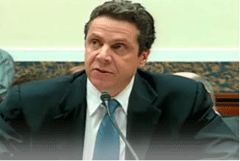
The Attorney General of New York Andrew Cuomo. (Courtesy of the Attorney General's Office)
CURWOOD: The Attorney General of New York, Andrew Cuomo, has subpoenaed five energy companies; AES Corporation, Dominion Resources Inc, Xcel Energy, Dyenergy Inc, and Peabody Energy. Mr. Cuomo suggests that their intent to build new coal-fired power plants could pose undisclosed financial risk to shareholders in light of global climate change. With us to put it into perspective is Patrick Parenteau, professor of law at Vermont Law School. Professor Parenteau, what does New York state’s securities law have to do with climate change?
PARENTEAU: First of all, the New York securities law is called the Martin Act. It’s a 1921 statute and it’s an act that former Attorney General, and now governor, Eliot Spitzer used very aggressively with Wall Street in the whole Enron scandal era to press corporations to reveal a variety of liabilities and risks associated with the way they were doing business—all in the nature of protecting investors. And of course with New York State one of the largest investors in the stock market is the State Employees Union, the pension plan, which is billions of dollars. So the Martin Act has been on the books for a very long time. A variety of Attorneys General have used it and now Andrew Cuomo is bringing it to bear on all this risk associated with climate change.
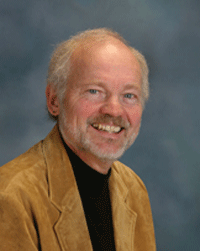
Dr. Patrick Parenteau, professor of law at Vermont Law School (Courtesy of Ed Chapin)
PARENTEAU: Well, here’s how it could work. Suppose the Congress enacts McCain-Lieberman, which will establish a national—what’s called a cap and trade program. And further suppose that Congress does not grandfather any coal plants. Now what happens is the companies that are operating existing plants and building new coal plants, let’s say, they typically rely on being able to pass on to the rate payers the costs of building these facilities and operating these facilities. But there’s a doctrine called the Prudence Doctrine, which says if the additional costs that are imposed could have been anticipated by the utilities they cannot pass those costs on to consumers. In other words the shareholders will absorb those costs. That’s the concern.
CURWOOD: How far might this investigation go back in history? For example Peabody Coal Company was a private company up until sometime in 2001. They had an initial public offering of stock on the scale of about a half a billion dollars. An initial public sale of stock by the way that came shortly after the White House Energy Task Force announced that there would be a big press for coal. To what extent my Peabody Coal face sanctions from Attorney General Cuomo if in that offering they hadn’t talked about the threat of climate change?

The Attorney General of New York Andrew Cuomo. (Courtesy of New York State Attorney General)
CURWOOD: A spokesperson for Peabody Coal has said that the Cuomo subpoenas are outrageous and said that the legal system was designed to protect, not harass, those such as Peabody, who are providing clean energy solutions for America. In his view, Attorney General Cuomo is on a witch-hunt. Your response?
PARENTEAU: That sounds like somebody who has something to hide, frankly. It would be far more prudent for Peabody spokespersons to say, ‘our books are open.’ When you hear terms like ‘this is a witch hunt’ and ‘he’s on a crusade’ or whatever, it suggests to me that maybe Cuomo’s onto something here.
CURWOOD: So we’re at the beginning of something here, we’re in the middle of something, we’re getting towards the end of something.
PARENTEAU: We’re at the beginning of the beginning. Climate change is truly a transformative issue in every sense of the word. It’s going to transform law, institutions, economies, governmental relationships—everything. And what we’re seeing in this instance is the effect of climate change on financial markets, on investor confidence, on who bears the risks and all of these questions are brand new for us, at this scale anyway. We just simply haven’t faced anything like climate change. And it’s just going to permeate throughout our entire governmental institutions and the market as well.
CURWOOD: Patrick Parenteau is senior council of the Environmental and Natural Resources Law Clinic and a professor of law at Vermont Law School. Thank you so much, sir.
PARENTEAU: Thank you, Steve.
CURWOOD: In a related story, 22 institutional investors and activists, ranging from Environmental Defense to the Kentucky State Treasurer have filed a petition with the Federal Securities and Exchange Commission asking that publicly-traded companies be required to disclose their financial risks from climate change.
Related links:
- Attorney General Andrew Cuomo’s Website
- Statement from Peabody Coal
- Dr. Patrick Parenteau’s website
- CERES (Coalition for Environmentally Responsible Economies)
[MUSIC: Cique “Strutt” from ‘Cique’ (Capri Jazz—2007)]
CURWOOD: Just ahead: name that shark. A leading environmental group opens the bidding for naming new species. But first this cool fix for a hot planet from Mitra Taj.
Cool Fix/Goloco
[CAR STARTING]
TAJ: When it comes to the carbon-emitting activity of driving, an Internet start-up is betting we care as much about our warming planet as we do our destinations.
Goloco has teamed up with the online social networking site Facebook to help passengers and drivers find each other. Members throughout the country post information about upcoming trips, look at where others are going, arrange rideshares, and lighten their carbon footprints.
The Department of Transportation says 86 percent of Americans drive to work alone. And for every mile driven, the average passenger car sends nearly a pound of carbon dioxide into the atmosphere.
Goloco hopes to make carpooling—not just to work but to shopping centers, sporting events, and concerts—fun. Members can check out the pictures, interests, and riding histories of their potential car mates before working out the details of the ride.
Sharing the 56 miles from Cambridge, Massachusetts to Providence, Rhode Island with Rima—a Beirut native who likes jazz and watching South Park—will save the driver $13 and spare the atmosphere 50 pounds of CO2. After every login, Goloco tells members—known as oLos-- how many pounds of carbon dioxide they’ve saved to date.
By sharing rides and getting closer to one another; oLos get closer to slowing climate change.
That’s this week’s cool fix for a hot planet. I’m Mitra Taj.
Related link:
Goloco Website
CURWOOD: If you or someone you know has a cool fix for a hot planet, please let us know. Call our listener line at 800-218-99-88, that's 800-218-ninety nine, eighty-eight.
Or email coolfix (all one word) @loe.org. That's coolfix@loe.org. Keep listening to Living on Earth.
ANNOUNCER: Support for the environmental health desk at Living on Earth comes from the Cedar Tree Foundation. Support also comes from the Richard and Rhoda Goldman Fund for population and the environment. This is Living on Earth on PRI. Public Radio International.
Liberation Ecology
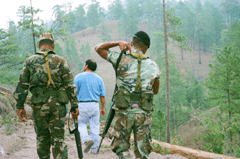
Father Andres Tamayo of Honduras, accompanied by two of his bodyguards. Father Tamayo is under 24-hour protection. (Photo: Marilyn Snell)
CURWOOD: It’s Living on Earth. I’m Steve Curwood. The Vatican recently declared that it is becoming the world’s first carbon-neutral state, thanks to the donation of carbon credits from a reforestation project in nearby Hungary. The move follows the Pope’s call for the international community to respect and encourage a green culture. And nowhere is that call being answered more than among activist Roman Catholic priests and nuns in Central America. In Guatemala and Honduras Catholic leaders are taking on multinational loggers and mining companies on behalf of the poor, sometimes at the risk of their very own lives.
Marilyn Berlin Snell traveled to Central America to report on this story for Sierra Magazine, and she joins us now. Welcome to Living on Earth.
SNELL: Hello
CURWOOD: Now, in your article you write mostly about Honduras and Guatemala, countries that are rich in such natural resources as gold and timber, yet more than half of the population there lives below the poverty line. What’s going on?

Political map of Central America. (Photo: Energy Information Administration www.eia.doe.gov)
CURWOOD: You spent a fair amount of time looking at some of the mines. Tell me what you saw in the area around the Marlin mine in Guatemala.
SNELL: The Marlin mine is in the highlands of western Guatemala and it’s almost 100 percent indigenous there. When the company- it was a Canadian company- came in around 2003, they offered to buy homes. These people are very poor, many of them sold their land. But nobody knew what open pit mining was and they got a rude awakening when the development started. They were blasting entire sides of mountains. I visited homes that were literally cracked in half because the blasting was happening too close to villages. They took me down to their farming plots and showed me where their sheep and cattle had died because they said they had drank contaminated water. And this is a huge mining operation. It just literally has sheered off entire sides of a mountain.
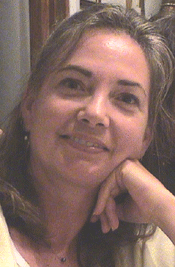
Sierra Magazine writer Marilyn Snell. (Courtesy of Marilyn Snell).
SNELL: When I was in Honduras I went to the Department of Olancho. And there a priest named Father Andres Tamayo lives and works. He founded an environmental organization some years ago to try and protect the forest in his region from both illegal logging and logging that is legal but is fairly rapacious because there’s very little oversight. And when Father Tamayo took me out into the forest to show me what was going on—it was pretty depressing. The loggers basically use bulldozers to push down anything in their way. Trees are taken from right from the edge of creeks, which contributes to the erosion that causes problems during heavy rains. There’s nothing left on the ground. It’s so parched because there’s no more canopy that very little can grow.
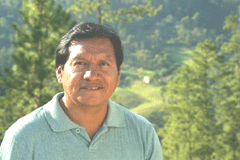
Father Andres Tamayo from Honduras has had his life threatened because of his work to stop illegal logging. (Courtesy of the Goldman Prize Foundation)
SNELL: Father Tamayo works with communities, with local people, to organize, sometimes get in the street, on the highways, and block these logging trucks. It’s very, very dangerous work. He also works in association with other Catholic groups around the country to—right now they’re trying to reform the forestry law. And Father Tamayo said he was hoping for some kind of reform within a year.
CURWOOD: Could you please describe Father Tamayo for me? In fact, maybe take me through the day that you visited him. What was it like to be with him and what is he like as a person?
SNELL: I got there and he was conducting a wedding ceremony in a very tiny cinderblock church in one of the villages he presides over. He was clearly a very popular man, quite jovial, and when he came out of the church he changed into an Amnesty International t-shirt. He’s on their watch list actually. And just said, “let’s go see what they’ve done to the forest.” So he got in his truck with three of his military bodyguards and he went out ahead and I followed him in another truck and we went out to the forest and fortunately he didn’t tell me until after we came back that last year this was where snipers had tried to kill him and instead killed a colleague that was next to him in the car. He told me that everyday he expected it would be his last. But he didn’t have a choice. This is what he felt that he had to do.

Father Andres Tamayo of Honduras, accompanied by two of his bodyguards. Father Tamayo is under 24-hour protection. (Photo: Marilyn Snell)
SNELL: Well, as one of the bishops told me he wants development. But he wants a humane and sustainable development, which is why he’s trying to get rid of the current mining law in Honduras—so that taxes are increased, so that more of the benefit goes to Honduras and less to foreign companies. They want to reform the forestry laws to protect the environment and again increase taxes so that the people of those countries benefit and not just foreign multinational corporations.
CURWOOD: To what extent do you see this in other parts of Latin America aside from Guatemala and Honduras?
SNELL: Well, in 2005 an American nun- Sister Dorothy Stang- was killed in retaliation for her work to protect the poor and the forests in the Amazon in Brazil. Another bishop from Brazil went on a hunger strike to protest a project to divert river water to wealthy agricultural concerns along the coast. And in Peru a bishop has requested scientists to go in and test the blood of villagers near a Doe Run mining-concern for lead poisoning. So those are just a few examples of the Catholic clergy really getting involved on the side of the poor and the disenfranchised when it comes to protecting natural resources in Latin America.
CURWOOD: Now if you go back to the liberation theology days, in the 70s and 80s there was a cardinal that came from Rome, his name was Ratzinger, to really quash this effort. Of course, he’s now the Pope. How does the Catholic Church in Rome now consider this type of political activism?
SNELL: I think that’s a very interesting question and I think it remains to be seen how it will all play out. But Pope John Paul II, the previous pope, was a fierce anti-communist. The current Pope Benedict shared these views. Both feared that liberation theologians were flirting with Marxism, godless Marxism. But I think times have changed. As recently as July, the Pope made a statement that environmentalism was a secular path to God.
CURWOOD: So, after this trip Marilyn, how do you feel about the prospects of these priests and bishops and clerics? Do they seem to be gaining ground in this movement that they have or is this a rearguard action?
SNELL: I think they’re gaining ground; [laughs] they have God on their side. They have villagers who are working in coordination with the Catholic Church to protect precious natural resources. So, though it was a little scary traveling with people who had to have 24-hour armed guards to protect them, it was also in a strange way hopeful and inspiring.
CURWOOD: Marilyn Berlin Snell is the author of a recent article called “Bulldozers and Blasphemy” in Sierra Magazine. Thank you so much.
SNELL: You’re welcome.
Related links:
- Marilyn Berlin Snell’s article, Bulldozers and Blasphemy
- Link to Goldman Environmental prize page abut Father José Andrés Tamayo
[MUSIC: Hamilton de Holanda “Passarim” from ‘Intimo’ (Adventure Music—2007)]
The Name Game
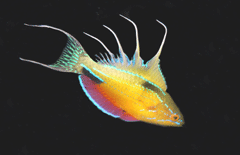
This species of flasher wrasse was discovered in April 2006. It is known only from the southern Bird’s Head Seascape, from Raja Ampat to Triton Bay. (Photo: Gerry Allen (c))
CURWOOD: When Conservation International finished an expedition last year off the coast of eastern Indonesia in an area known as Bird's Head Seascape, the scientists had discovered more than 50 new species, including a number of fish. This fertile ocean area has been hit hard by commercial fishing, as well as by the dynamiting and poisoning of coral reefs, and many of these newly discovered creatures are at risk of going extinct.
So, to raise some money to fund a protection project for the area, Prince Albert II of Monaco has joined hands with the conservation group and the Monaco-Asia Society to host a "Blue Auction." And on the block at the affair? The scientific naming rights for ten of these new species. Peter Seligmann is the founder and CEO of Conservation International.
SELIGMANN: We hope to raise at least two million dollars for the region and we may exceed that. This is an area that needs financial support. It is an area that is under siege and under threat. What's wonderful is that the government has just decided that their future, for their communities, is going to be better served if they develop sustainable use of the resources. So that we've got a moment when the communities and the government are saying, ‘we understand how important this is, we want to take some action to protect it. We are going to prioritize caring for this landscape and this seascape.’
CURWOOD: Now how did you come up with the idea for this auction?
SELIGMANN: I was diving in Raja Ampat in the Bird's Head peninsula in the very eastern part of Indonesia and was with the scientists that work for Conservation International and we were talking about this juxtaposition of this exquisite diversity and brilliance and beauty of life and yet the enormous threat to the area and we just knew that there was a very, very, real need for funding to ensure that Indonesians would have the training to be able to protect it. And the scientists said, ‘why don't we auction off the opportunity to name species after yourself?’
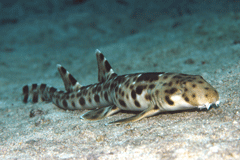
The completely singular evolutionary path this shark has taken gives it pectoral fins uniquely developed for "walking." This species was discovered last year. (Photo: Gerry Allen (c))
SELIGMANN: Yes, well first they were all discovered at the center of a region that’s referred to as ‘the coral triangle’ and it's really the area that we believe is the richest in terms of marine diversity of any place on the planet. One of the new species—actually there are two new species of sharks that were discovered—are called ‘walking sharks.’ And they're very small sharks—maybe three or four feet—and they just use their fins, the four fins, on the bottom of their body as feet. You have to really see it to believe it.
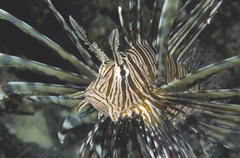
Lionfish are one of the most dangerous reef fishes, with poisonous spines that cause excruciating pain for up to three days after a wound is inflicted. First collected from Cendrawasih Bay, this new species has now been photographed from Northern Sulawesi to eastern Papua New Guinea. (Photo: Gerry Allen (c))
And there are flashing wrasses, which are these just beautifully colorful fish that when they want to—when the males want to attract the females for courtship—they have bioluminescence. They just start flashing down in the deep. I always think of it as a combination of Dr. Suess and Candy Land.
CURWOOD: [laughs] And they're not so different from humans. I guess that flashing fish is like the guy in the flashy red convertible at the beach, huh?

This species of flasher wrasse was discovered in April 2006. It is known only from the southern Bird’s Head Seascape, from Raja Ampat to Triton Bay. (Photo: Gerry Allen (c))
CURWOOD: Now what happens after somebody wins a bid to name one of these species? How will the fish actually be named?
SELIGMANN: Well, the chosen name—the name of the bidder or the name of the bidder's child or whatever, will be latinized and then will be submitted to the International Commission for Zoological Nomenclature through a publication which is called Aqua, which is a journal of ichthyology or fish. And peers will review it and they will approve it.
CURWOOD: So, let's say I had a cell phone company and the lionfish was the logo. I mean, could I have that name in my company? Could it be the Living on Earth cellular?
SELIGMANN: Well the names are going to be reviewed by a panel so we'll make some decisions if we find that there is a situation that would be inappropriate. We have a panel that can vet that. But theoretically, a company could pass this group and could be approved by this group and you could end up with a company being immortalized through a naming opportunity.
CURWOOD: Peter Seligmann is the founder and CEO of Conservation International. Good to talk with you.
SELIGMANN: Thank you so much, talk to you soon.
CURWOOD: To see pictures of the walking shark and other creatures in the auction, as well the results of the bidding, please go to our website, l-o-e dot org.
|
UPDATE - The Blue Auction, held on September 20th, surpassed its goal of raising two million dollars by a hair! The grand total for the naming rights of ten newly discovered marine species, as well as two other prizes, raked in $2,015,000.00. The big winner was the "walking shark," whose naming rights alone brought in $500,000. The winners will submit their names of choice to the International Commission for Zoological Nomenclature where they will be reviewed by a panel. The funds that were raised at the Blue Auction will be used directly to benefit three marine conservation programs in Indonesia: The Marine Empowerment Initiative, The Marine Enforcement Initiative and The Marine Conservation Education Initiative.
Related links: [MUSIC: Peter Dixon “Aviatrix” from ‘Shady Planet’ (Peter Dixon Music—2007)] Alex (1976 – 2007)
(Photo: Arlene Levin-Rowe, the Alex Foundation) CURWOOD: At the time of his death earlier this month at the age of 31, he was working with researchers at Harvard and Brandeis universities. As a fan who followed his career for more than two decades, Sy Montgomery offers this tribute to Alex the parrot. MONTGOMERY: When he died, I felt like some folks did when Elvis Presley or Lady Diana passed away. Alex the African Grey Parrot was one of my heroes. Ever since he left the pet store for the lab, Alex had worked with researcher Irene Pepperberg on a monumental project. For most of his life, he studied the English language—and in doing so, changed the way humans look at our place as a species in the great order of life. 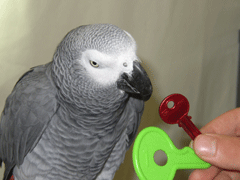 (Arlene Levin-Rowe, the Alex Foundation) First Washoe the chimp—later Koko the gorilla—learned American Sign Language. Then dolphins and sea lions learned to touch word-like symbols in syntactical order. There were others. But some linguist or other was always shooting them down. They complained the animals weren’t using language as we do.  (Photo: Arlene Levin-Rowe, the Alex Foundation) Alex revealed a mind remarkably like ours. His last words, spoken to Pepperberg the night before he died, were these: “You be good. See you tomorrow. I love you.” Some still claim Alex wasn’t really using language. But I mean, come on! Here he is, telling us, in plain English, that he wants a nut! What could be clearer than that? When Alex spoke, a member of a species more closely related to dinosaurs than to humans was talking with us. And that answered the question, for me anyway, beyond any doubt: Language is not the uncrossable barrier between people and animals. Which suggests this ‘great divide’ between our kind and other species is just something we made up. In speaking his mind so clearly, Alex has done us a great service. He has helped to reunite humanity with the rest of the living world. [WOMAN SPEAKING WITH PARROT] Related links: [MUSIC: Winston Benet Project “Wind Beneath My Wings” from ‘Passionate Piano – Vibes’ (Compose Records—2006)] CURWOOD: Commentator Sy Montgomery is the author of “The Good, Good Pig”—who by the way, did not speak English. Next time on Living on Earth: [TESHEKPUK LAKE AMBIENT BIRD SOUND] CURWOOD: Oil companies are eager to tap Alaska’s North Slope for its rich oil reserve, but the region’s also rich in bird life. SENNER: You have all of these birds arriving from literally all around the world and they’re there for one purpose and that is to find a mate and nest and produce young and then get out of there again before things freeze up. CURWOOD: Oil and birds-- a journey to Teshekpuk Lake. Next week on Living on Earth. Living on Earth is produced by the World Media Foundation. Our crew includes Ashley Ahearn, Eileen Bolinsky, Bruce Gellerman, Ian Gray, Ingrid Lobet, Emily Taylor and Jeff Young—with help from Bobby Bascomb and Kelley Cronin. Our interns are Alexandra Gutierrez and Mitra Taj. Thanks this week to Jan Hartley and Nancy Chambers of the Alex Foundation. Jeff Turton is our technical director. Alison Lirish Dean composed out themes. You can find us at L-O-E dot O-R-G. I’m Steve Curwood. From all of us here at Living on Earth, thanks for listening. ANNOUNCER: Funding for Living on Earth comes from the National Science Foundation, supporting coverage of emerging science; And Stonyfield Farm: Organic yogurt and smoothies. Stonyfield pays its farmers not to use artificial growth hormones on their cows. Details at Stonyfield dot com. Support also comes from you our listeners, the Ford Foundation, the Wellborn Ecology Fund, and Pax World Mutual Funds—socially and environmentally sustainable investing. Pax World: For tomorrow. On the Web at Paxworld dot com. ANNOUNCER 2: PRI Public Radio International Living on Earth wants to hear from you!Living on Earth Newsletter [Click here]
Donate to Living on Earth! NewsletterLiving on Earth offers a weekly delivery of the show's rundown to your mailbox. Sign up for our newsletter today!
|







